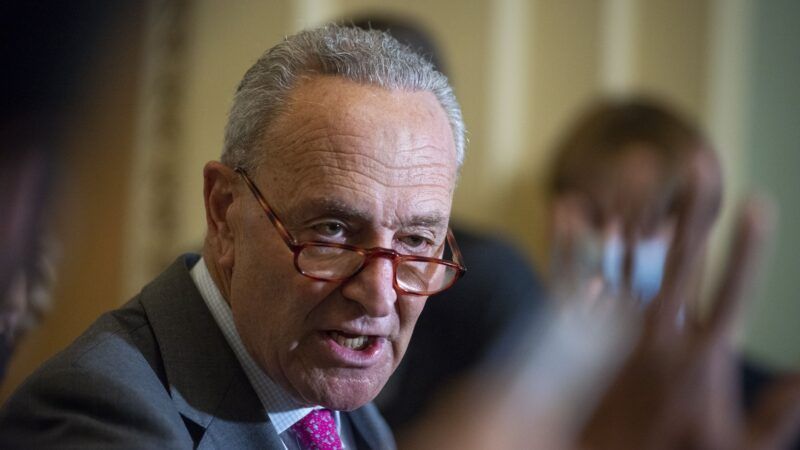The Bipartisan Infrastructure Bill Is a Sham
The Senate just passed a $1.2 trillion bipartisan infrastructure bill—and teed up another $3.5 trillion bill in the process.

The $1.2 trillion bipartisan infrastructure bill is a sham. Not only that, it's a sham that sets up a much bigger round of explicitly partisan spending later in the year.
In a climactic vote this afternoon, 19 Senate Republicans, including Senate Minority Leader Mitch McConnell (R–Ky.), signed onto the bill, which calls for $550 billion in new spending as part of more than $1 trillion in funding for roads, bridges, waterways, and broadband. The bill also includes essential infrastructure provisions like, er, requiring unproven new drunk-driving-prevention technology on cars, a vaping ban on Amtrak, and new reporting requirements for cryptocurrency.
The Republicans repeatedly claimed that the spending would be fully paid for, despite plenty of reasons to suspect that it won't be. As Reason's Eric Boehm reported, the Congressional Budget Office, Congress' nonpartisan scorekeeper, estimates that the bill would add at least $256 billion to the deficit, and probably more like $400 billion. Nineteen Republicans voted for it anyway.
The same Republicans also claim that while they support the infrastructure spending, they are deeply opposed to the rest of the Democratic agenda, which is being moved separately as part of a $3.5 trillion budget reconciliation package that Democrats plan to pass on a party line.
You might think of the budget resolution as the "everything else bill." It funds the bulk of President Joe Biden's agenda that is not physical infrastructure. It's focused largely on climate and social spending—vastly increasing federal funding for Medicare, Obamacare, and a yet-to-be-determined new federal health program as well as welfare-style payments to parents of children and the "first ever Civilian Climate Corps."
Democrats have insisted that this bill too will be fully paid for, but they haven't spelled out the precise mechanisms. And reconciliation instructions released earlier this week allow for as much as $1.75 trillion in deficit spending over the next decade; like the infrastructure bill, it's unlikely that this "fully paid for" legislation will actually be fully paid for in the end.
The $3.5 trillion budget plan, in other words, is a big government, progressive-agenda spending bill (even if the progressives would have preferred an even bigger reconciliation package). It's the sort of legislation that Republicans claim to oppose, and have promised to fight vigorously.
The Republicans signing onto the infrastructure bill have argued, in effect, that doing so restrains Democratic ambitions. In this telling, the bipartisan bill serves as a more modest alternative to Democratic spending plans—a compromise that forces Democrats to chisel down their ambitions. It's no such thing.
Instead, the better way to look at the two bills is as a package deal. That's how Speaker of the House Nancy Pelosi (D–Calif.) sees it. She's been clear from the start that she will only take up the Senate's bipartisan bill as a two-part play, along with the $3.5 budget plan. "There ain't no infrastructure bill without the reconciliation bill," she said in June. That's how one key centrist Senate Democrat, Joe Manchin (W. Va.) sees it too: Late last month, he said that "if the bipartisan infrastructure bill falls apart, everything falls apart." Sen. Tim Kaine (D–Va.) said last month that if somehow the bipartisan bill fell apart, Democrats would just…add $600 billion or so to their reconciliation bill, meaning they'd get $4.1 trillion or so either way. And while Biden has since (kinda-sorta-maybe) backtracked, he has also said that the two bills could work in "tandem."
Meanwhile, the Congressional Progressive Caucus released a statement today saying that its members "won't support a bipartisan bill without a bold reconciliation bill to advance our priorities." It's a two-bill deal.
The best way to think of these two pieces of legislation, then, is not to think of them as two entirely separate bills, but as a package deal representing $4.1 trillion in spending on the Biden agenda. And rather than restraining Democratic spending ambitions somehow, the infrastructure bill tees up the rest of the package, advancing the ball on the larger Biden agenda.
So when 19 Senate Republicans turn out to vote for the infrastructure deal, arguing that it's a fully paid for compromise that doesn't raise any taxes, they are effectively supporting a $4.1 trillion tandem package, and everything that may end up in it, even while pretending that they are adamantly opposed.
To understand why this happened anyway, it's important to understand the almost mystical allure of bipartisan dealmaking in Congress, especially in the Senate. In parts of official and high-status Washington, bipartisan deals are seen as a good unto themselves, almost independent of what's in them. And for a certain type of lawmaker, that allure has an even greater appeal now, in the post-Trump era, when one of the Senate's own is in the White House. Biden himself is a true believer in the power of across-the-aisle dealmaking.
At the same time, Congress has been consumed by gridlock and dysfunction, and as a result there has been a growing sense, shared in part by many frustrated lawmakers, that it has lost the ability to get things done.
The bipartisan infrastructure deal is intended as a kind of a rejoinder to that narrative, an answer to the question: Who says Congress can't get big things done? The $1.2 trillion bipartisan infrastructure deal, and its $3.5 trillion partner budget bill, says yes, Congress can get big things done—big, terrible things.


Show Comments (213)